
Black Bart
story by Carol Tallman Jones
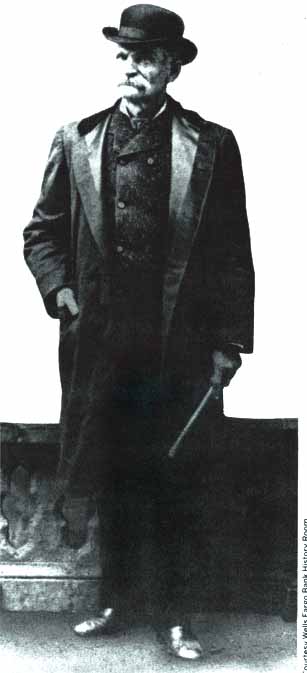
Charles E. Boles
1830 or 1832 - c. 1917 ??
Jefferson County, NY
aka Black Bart; Charles E. Bolton; T.Z. Spalding; Po8
Black Bart brought gentlemanly behavior to stagecoach robbing.
Wearing a flour sack with cutout eye holes over his derby-topped head and wielding a shotgun, this pesky little bandit plagued the stage lines of Wells Fargo for over eight years during the 1870s and 80s. He relied on his quick feet for getaways, melting ghost-like into the brush. His deep, sepulchral voice and polite confident manner added to this eerie effect. Demonstrating a puckish sense of humor, he frequently left a poem handwritten on foolscap in the emptied strongbox, which infuriated Wells Fargo officials. The most often quoted of these is the following:
Here I lay me down to sleep,
To wait the coming morrow;
Perhaps success, perhaps defeat
And everlasting sorrow,
I've labored long and hard for bread
For honor and for riches,
But on my corns too long you've tred
You fine-haired sons of bitches.
Let come what may I'll try it on,
My condition can't be worse --
And if there's money in that box
'Tis money in my purse.
--Black Bart, Po8
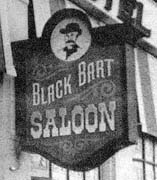
San Franciscans remember their most famous bandit with the Black Bart Saloon, located in the plush Hotel San Francisco just a nuggets throw from the Civic Center.
Revatively little is known of the birth and childhood of Charles Boles, who established residence in San Francisco as C.E. Bolton shortly after the California gold rush subsided. His life up until his first stagecoach robbery has never been fully documented, though Bolton himself claimed to have been an officer in the Union army prior to his life as a highwayman.
It was the era of the gunslinger, the road agent and the avenging lawman. San Francisco was well on its way to becoming the queen city of the Pacific Coast by the time Bolton arrived in the mid 1870s posing as a wealthy mine owner. Wells Fargo & Co., established 1852 in New York, was by now a huge financial success. Hauling passengers, freight, mail, cash, coin, silver and gold bullion in their 2500 pound Concords, W.F. & Co. had but one major problem: Armed robberies of its stages. Organized gangs and unscrupulous men killed drivers and robbed passengers indiscriminately while relieving the stages of overloaded strongboxes.
One highwayman was the exception. Although he carried a shotgun to back up his polite request to "Please throw down the strongbox", Charles Bolton, or Black Bart as he was to be called, never fired a shot at a driver nor harassed or robbed stagecoach passengers.
One report of his first known robbery goes like this:
July 26, 1875, Calaveras County, California --- On Funk Hill, four miles from Copperopolis, the Sonora to Milton stage is stopped by a shotgun wielding, flour sack wearing bandit. The Wells Fargo driver, John Shine, is persuaded in a deep voice ringing with authority to "please" throw down the strongbox or face the wrath of the half dozen rifle barrels poking from the brush. A long linen duster covering his clothes and flour sack over the bowler hat atop his head, the lone bandit looks much taller than his actual five-feet-seven-and-one-half inches. In fear, a female passenger tosses her purse from the stage. Bolton returns the purse and advises the passengers it's not their money he's after, but the property of Wells Fargo. The coach is permitted to go on its way, and Black Bart makes off with a total of $160. Investigators find the "gang" hiding in the bushes to be sticks arranged to look like protruding rifle barrels. A $250 reward is immediately offered for the bandit's capture.
That same year on December 28, the San Juan to Marysville stage was similarly robbed.
Meanwhile in San Francisco, C.E. Bolton "the mining engineer" lives in a modest hotel south of Market Street. He pays his bills on time and is an excellent tenant. His occasional trips to "check on mining interests" are not questioned. Acquaintances who know the unassuming little man never suspect that he and Black Bart could be one and the same. The press gleefully publishes every bit of light verse found after each of these robberies.
 So here I've stood while wind and rain
So here I've stood while wind and rain
Have set the trees a-sobbin'
And risked my life for that damned box,
That wasn't worth the robbin'.
Black Bart the Po 8
Still a novice at this new profession, in 1876 Bolton committed only one robbery. Due north of Frisco near the Oregon border on June 2, the Roseburg-to-Yreka stage was the prize. Now using the cover of darkness, the horseless highwayman in flour sack and duster vanishes as quickly as he'd appeared.
This unique modus operandi did not vary for twenty-eight holdups, though robbery number twenty-three, attempted nine miles outside of Strawberry, California, on July 13, 1882, was aborted when Wells Fargo messenger George W. Hackett fired at the bandit and sent him running for cover. As usual, Black Bart the Po8 disappeared without a trace.
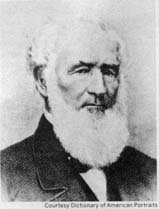
Henry Wells (1805 - 1878), photo top right, and William George Fargo (1818 - 1881), photo lower left, were partners in a company known as the Western Express. A later company bore the name of Wells Fargo & Co.
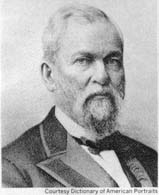
The majority of Black Bart's holdups were committed in Southern Oregon, in Northern or in Calaveras County, California, 150 miles northeast of San Francisco where Wells Fargo operated many of its stagecoaches. A detective force headed by James B. Hume, a dedicated lawman already on Wells Fargo's payroll when Black Bart began his career, generally kept robberies in that area in check. The exception, again, was the vanishing little man with the deep voice. Disturbed at their losses, exasperated by the mild-mannered and middle-aged bandit's repeated successes, and undoubtedly humiliated by the taunting poems left in empty strongboxes, Wells and Fargo set Hume on the Po8 trail. Strongboxes were now bolted to stagecoach floors. Not known to have ever used any transportation other than "shanks mare" (his own two feet), this lone holdup artist would surely stop now.
Below is James Hume, whose alert detective work ended the career of bandit Black Bart.
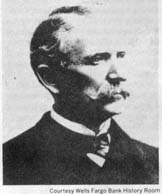
Relentless, Hume examines each scrap of paper found and questions every witness. What he is able to ascertain about the gentlemanly bandit leaves him exasperated. Black Bart conducts himself in such a polite fashion during holdups -- no swearing or rude language -- that it's impossible to put him in a class with other highwaymen Hume has known. Much to the detective's dismay, the identify of Black Bart remained a mystery.
After a fourteen month sabbatical, on August 3, 1877, Black Bart strikes Wells Fargo again, robbing the Point Arenas-to Duncan's Mill stage. That made four holdups in two years. In the year following, 1878, Bart doubled that figure. Awaiting the bolted strongbox with pickaxe and hammer, on September 16, 1880, not only did Bart relieve the Roseburg stage in southern Oregon of over a thousand dollars worth of gold and paper money, he humiliated them again a week later with a repeat performance. By now the total was up to fifteen, and those who followed the exploits of this now notorious bandit were beginning to lose count. In 1881 an additional five successful holdups occur, setting a new record for a single year. It was on July 13 in 1882 that holdup number twenty-three went awry, and though fired upon by the armed W.F. & Co. messenger, Black Bart refused to fire back. Perhaps for good reason, for it is now assumed that his ever-present shotgun probably wasn't even loaded. The year, however, turned out to be a good one in Bart's record book and six miles from Cloverdale the stage from Lakeport to Cloverdale fell victim to holdup number twenty-five on November 24. Within a mile of that robbery, in April the following year, 1883, the elusive bandit honored that same stage with an encore.
Next the Jackson to Ione City stage was robbed four miles from Jackson. After this June 23 holdup, Black Bart gave Wells Fargo a four month rest.
Special officer Hume was still in hot pursuit, eagerly reviewing any inadvertent clues. He knows by now that Black Bart travels on foot, and suspects the robber occasionally stops by some farm house to refresh himself and to buy a meal, for reports of a polite and dapper man doing so have filtered back. Hume, however, proceeds with caution, not wanting to pursue the wrong man.
On the morning of November 3, 1883, Wells Fargo driver Reason McConnel sets out from Sonora to Milton. En route, he stops at Rolleri's wayside inn to refresh himself and agrees to allow nineteen-year-old Jimmy Rolleri to hitch a ride to Funk's Hill. The boy takes a rifle along, hoping to get lucky and to bag some game along the way. Jimmy gets off to stalk game in the nearby brush, while the stage moves slowing up the steep Funk's Hill grade.
Suddenly a masked man wearing a long linen duster jumps out in front of the lead horses and levels a shotgun at McConnel. "Throw down the box, please." "Impossible," the driver replies, knowing good and well he faces the infamous Black Bart. "It's bolted inside the stage." McConnel complied with Bart's next command, got down, unhitched his horses and began to lead them to the top of the hill. Though he didn't look back, the sound of the robber's attempt to dislodge the strongbox with a pickaxe was unmistakable. Over the crest of the rim, McConnel saw young Jimmy Rolleri rushing back to investigate the racket. Excited at the thought of getting a shot at the highwayman, the driver briefly explains the situation while grabbing the lad's gun and hurrying back to the crest of the hill. Lying flat on the ground, he snaps off a couple of shots, but unfamiliar with the gun, McConnel's aim was off and he missed his target.
Hearing the shot and at last having broken into the box, Black Bart glances up, then calmly pulls a sack of gold through the splintered hole. Only then, does he head for the safety of the bushes. Young Rolleri recovers his gun and pops off a shot. "I got him, I got him," yelled the teen as the masked man stumbles. But as those words escaped, the bandit caught his balance and did the same, disappearing into the brush.
As Black Bart attended to his flesh wound, the two victims head in to report their trouble to the Copperopolis sheriff. It seemed that the Po8 had made another clean getaway.
But that was not the case; this time, almost in the exact spot where in 1875 he'd robbed his first stagecoach, Black Bart's luck had run out. He'd left behind a hat and a valise containing food, ammunition, and a pair of glasses. Wounded and understandably a bit shaken, Bart left behind one more tell-tale clue; whether while attending his wound or in finding a place to hide the sack of stolen gold, who is to know. In either case, it was a very small thing that would prove his downfall; the inked laundry mark on one corner of a soiled handkerchief.
Once in possession of the handkerchief, Hume and associate Henry Nicholson Morse began eliminating one by one San Francisco's ninety-one laundries, and finally traced it to Ferguson & Bigg's California Laundry on Bush Street. From there it was a short step to the bandit's address and his arrest. Along with the flour sack, shotgun, and long linen duster found in the hotel room of C.E. Bolton, was a bible -- and inside was written what is believed was Black Bart's true name, Charles E. Boles. The bible, a gift from his wife, bore a date of 1865.
As history has it, Boles was born and raised in upper New York State and had been a farmer until he married and moved to Illinois just before the Civil War. He served as a sergeant in the 116th Illinois Volunteer Infantry. After the death of his family members, he moved to California to seek his fortune. After trying a number of odd jobs, even panning for gold, he turned to stagecoach robbing. He reportedly invested much of his "loot" in small business which provided a modest income, though whenever money was short, would again hit the Po8 trail. After days of denying his guilt, he finally admitted that he had committed several robberies, but only those occurring before 1879 -- mistakenly assuming, historians claim, he'd be protected against prosecution by the statute of limitations. Bart denied both Boles and Bolton as his true name. When booked, he gave his name as T.Z. Spalding.
Charles E. Boles, alias C.E. Bolton, alias Black Bart the Po8 -- or was it T.Z. Spalding? -- was convicted and sentenced to San Quentin Prison, arriving there on November 21, 1883. A lenient Wells Fargo charged him only with his last robbery, and his sentence was for just six years. The mild-mannered convict spent his measured time pursuing his avocation: reading. He was released for good behavior on January 21, 1888 after serving four years and two months. His eyesight failing, his hair whitened, and one ear gone deaf, he had aged considerably. He sought only to escape the newsmen surrounding him when he stepped from the prison gates. Addressing them, he claims that the days of Black Bart are over.
Yet on November 14, 1888 another Wells Fargo stage was robbed. The lone bandit left the bit of doggerel, also printed above, that read:
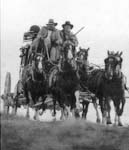 So here I've stood while wind and rain
So here I've stood while wind and rain
Have set the trees a-sobbin'
And risked my life for that damned box,
That wasn't worth the robbin'.
Detective Hume examined the note, and comparing it with the genuine Black Bart bits of poetry of the past, declared the new verse a hoax. This was the work of another man, the detective claimed, stating that he was certain the real Black Bart had permanently retired. Rumor kept the Po8 legend alive, reporting then that Wells Fargo had pensioned off the aging gentle bandit on his promise to stop no more of its stages. The notion became popular that Bart received a handsome annuity until his death, which New York newspapers reported as being sometime in 1917. This date is unconfirmed, however. Sometime in 1900, Detective Jim Hume had received a report that the old man died while on a hunting trip high in the California mountains. But this is still another unconfirmed report.
What is known is that upon his January 1888 release from San Quentin, Black Bart moved into a rooming house in San Francisco. In February, the room is found empty and abandoned. Although reporters and writers had the outlaw living in hundreds of different places and robbing stages until Wells Fargo decided to close its doors, Bart was never seen again. As was his mysterious way, Black Bart had vanished like an apparition -- this time forever. Today the legend looms like a gentle mist veiling the reality. Undoubtedly the way the bandit would have wanted it.

Top of Page
Copyright 1997-1998 LaVone Luby -- All Rights Reserved
Site Designed 1997 by Carol Tallman Jones -- All Rights Reserved
|